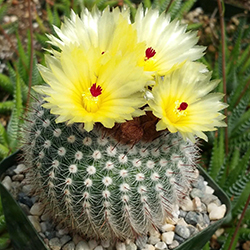|
||||||
Free Notocactus Scopa Plants The attraction of the Notocactus lies not just in its very pretty flowers, but also in the fine spines, which give an appealing ‘glow’ to the plant, which means that even when it is not in flower it still looks very attractive. The Notocactus is therefore a worthy addition to any collection of cacti and succulents. There are several varieties in different colours. Most specimens produce large, bold flowers that may last up to a week before fading, providing a highly colourful display. As with many cacti, it is essential to provide the plant with a winter rest, ensuring that it is kept both on the dry side (but not allowed to dehydrate and shrivel) and cool, at about 10°C (50°F). After removing offsets for propagation, wait a few days until a hardened callus has formed at the site ofthe wound. They are then ready to pot. Plant type : Flowering cactus with cylindrical habit Season of interest : Summer Size : 7.5-15cm (3—6in) Flower : Rayed, 5cm (2in) wide, bright yellow, produced in summer Leaf : Globular then cylindrical green stem with fine white and red-brown spines Temperature : 10-28°C (50—82°F) Aspect/Light : Full sun Humidity : Low Watering : Evenly moisten compost in spring and summer, allowing to dry a little before re-watering; water enough to prevent dehydration in autumn and winter Feeding : Once every two to three weeks with half strength flowering plant fertilizer in spring and summer Propagation : Remove offsets in late spring or summer, allowing cut surface to dry for a couple of days to produce a callus, then pot in cactus and succulent compost at 20-22°C (68-72°F) Potting : Cactus and succulent compost Problems : Mealy bug, root mealy bug Availability : Occasionally available spring and summer Uses indoors : Good windowsill or conservatory plant Other varieties : N. haselbergii- white spines; small, red flowers, N. leninghausii-golden-yellow spines; large, yellow flowers |
||||||
|
||||||
